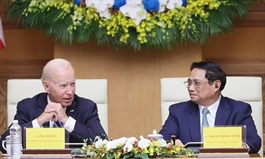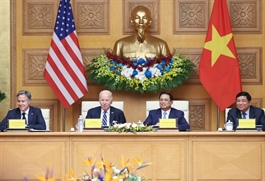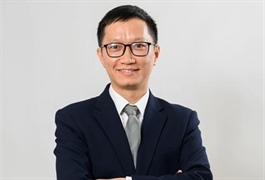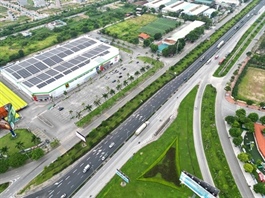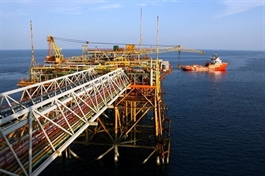Prudently addressing Vietnam’s economic liquidity
Prudently addressing Vietnam’s economic liquidity
Vietnam’s economic growth has been slowing since November 2022. This prolonged decline is unusual for Vietnam compared to previous crisis cycles. The Purchasing Managers’ Index has remained very low since then, at 46.4 points, slowly approaching 49 points in July and reaching 50.5 points last month, except for February this year during the Lunar New Year holiday.
This indicates that Vietnam’s economic recovery has improved but remains slow, significantly below the National Assembly’s initial expectations set at the beginning of the year.
Inflation in Vietnam has decreased rapidly and appears to have surpassed worrisome levels. It is expected to be around 3.1-3.2 per cent for the entire year, significantly lower than the initial target of 4-4.5 per cent. While core inflation remains relatively high, averaging around 4.5 per cent, it is primarily driven by slight increases in the prices of non-oil commodities, rather than reflecting an increase in the money supply by the State Bank of Vietnam (SBV).
The government’s fiscal and monetary policy management has seen significant improvements in flexibility and relaxation, contributing positively to macroeconomic stability. This achievement has garnered high praise from many international analysts and positions Vietnam as one of the most economically stable countries in Southeast Asia.
Consequently, foreign direct and indirect investment continue to flow into Vietnam, even as these investment streams decline in other emerging markets, despite high interest rates in the United States and Europe.
Public investment remains the most critical factor in sustaining recovery, thanks to the determined direction of the government, adhering to a “no retreat” principle. Consequently, disbursements for public investment in many provinces have met or exceeded planned targets.
For the first time in many years, the government has implemented specific measures to rescue the corporate bond market and the real estate market, including special task forces to address legal bottlenecks at key enterprises, boosting market confidence. Handling bank bad debts and corporate bond bad debts has been carefully guided and implemented.
Although the asset market is still challenging, the prospects for recovery are clearer. This has allowed the stock market to overcome the risk of a collapse and exhibit relatively good growth compared to many other regional stock markets.
Exports and imports have shown signs of improvement in recent months after a steep decline in the first quarter of 2023. However, to further enhance export recovery, besides seeking new markets, there is a significant challenge in compiling reports and plans for carbon credit utilisation.
Recently, the VND has depreciated slightly against the USD, primarily due to the latter’s global price increase. However, the exchange rate between the two remains relatively stable, with a depreciation of less than 2 per cent throughout 2023.
The growth forecast for the entire year is expected to reach around 5-5.3 per cent, and 5.5 per cent for 2024. Inflation in 2023 is projected to be below 3 per cent, and in 2024, below 3.5 per cent.
The most significant challenge facing the Vietnamese economy is overcoming the real estate market crisis, primarily due to an imbalance in market segments. To address this issue effectively, it is essential to focus not only on legal procedures for the luxury housing segment but, more importantly, to stimulate the affordable housing segment and significantly increase the housing supply, especially in major cities.
To achieve this, government support for the affordable housing segment should not interfere with the profit motives of project developers or bind them with government policies regarding the beneficiaries of social housing.
Additionally, government support policies should directly target homebuyers, including credit policies and eligible policy recipients. Only by doing so can the social housing sector experience rapid growth, and the crisis in the market segment structure can be addressed. This approach will create a new real estate price level, free from speculation, and this price level will restructure the market.
Real estate companies that can adapt to this new price level will survive, while those that cannot will face bankruptcy. Avoiding a situation where credit is loosened exclusively for the luxury housing segment would allow the real estate market to recover on the old foundation, where prices were driven up by speculation, leading to abandoned properties despite demand from those who need housing and can afford it.
The second major challenge facing the Vietnamese economy is the need to properly address economic liquidity. A liquidity storm has passed in many countries but continues to wreak havoc in Vietnam due to the money supply growth lagging significantly behind GDP growth calculated at current prices, in the context of a sharply reduced money velocity, dropping from 1.8 to 2.5 cycles annually to now just 0.64 cycles per year.
This is why real interest rates in Vietnam are currently very high, even though the SBV has taken measures to reduce interest rates. Long-term lending interest rates in Vietnam average around 9-11 per cent, with some as high as 14-15 per cent.
It is necessary to bring medium-term lending rates down to 7-8 per cent and improve access to capital for enterprises. Lending assessments should prioritise borrowers’ repayment capacity over collateral to enable businesses to accept external orders and invest in technological innovation to meet future carbon credit requirements.
This is a critical issue that will determine the sustainability of economic recovery. The SBV needs to normalise its credit relationships with commercial banks, including refinancing and re-discount channels. We have not yet established a true market mechanism between the money supply and interest rates. Therefore, it is challenging to compare interest rate management of the SBV with that of central banks in other countries.







